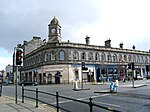South Leith Parish Church
1487 in ScotlandBuildings and structures in LeithCategory A listed buildings in EdinburghChurch of Scotland churches in EdinburghListed churches in Edinburgh ... and 3 more
Protestant churches converted from Roman CatholicismReligious buildings and structures completed in 1487Use British English from February 2015

South Leith Parish Church, originally the Kirk of Our Lady, St Mary, is a congregation of the Church of Scotland. It is the principal church and congregation in Leith, in Edinburgh. Its kirkyard is the burial place for John Home (author of Douglas) and John Pew, the man from whom the author Robert Louis Stevenson reputedly derived the character of Blind Pew in the novel Treasure Island. The church has been repaired, used as a magazine and reconstructed but still looks similar to its appearance on a 1608 seal.
Excerpt from the Wikipedia article South Leith Parish Church (License: CC BY-SA 3.0, Authors, Images).South Leith Parish Church
St Anthony Street, City of Edinburgh Leith Harbour & Newhaven
Geographical coordinates (GPS) Address Nearby Places Show on map
Geographical coordinates (GPS)
| Latitude | Longitude |
|---|---|
| N 55.971944444444 ° | E -3.1727777777778 ° |
Address
South Leith Parish Church Halls
St Anthony Street
EH6 5LB City of Edinburgh, Leith Harbour & Newhaven
Scotland, United Kingdom
Open on Google Maps









